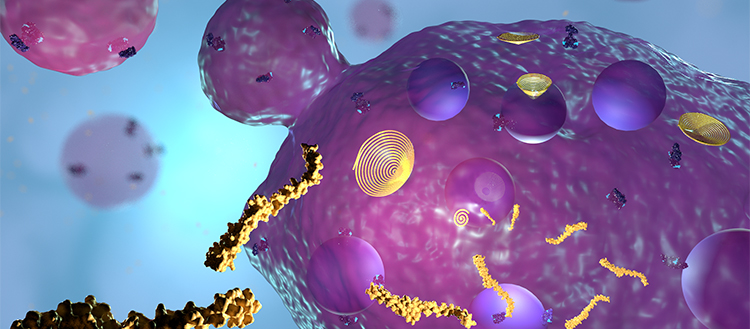Cells relax their membrane to control protein sorting
UNIGE researchers have succeeded in measuring the tension of the membrane of an organelle forming inside a cell.

@ Margot Riggi
The tension in the outer membrane of cells plays an important role in a number of biological processes. A localised drop in tension, for example, makes it easier for the surface to be bending inward and form invaginations that will become free vesicles inside the cell. These are delimited by a membrane that contains all proteins originally present in the invaginations. A fundamental function of these so-called endosomes is to sort proteins to their cellular destination, e.g. reutilization or degradation. Are the functions of endosomes modulated by variations in tension? Scientists from the University of Geneva (UNIGE) and the Chemical Biology National Centre of Competence in Research have answered in the affirmative thanks to their high-precision research published in the journal Nature Cell Biology. Using molecular probes that they devised themselves, the multidisciplinary team has succeeded in two areas: they have measured the membrane tension of these endosomes that form part of the cell’s sorting center; and they have succeeded in showing that this relaxation helps form vesicles within endosomes, i.e. vesicles within vesicles or “intraluminal vesicles”, which carry the proteins to be degraded. It is a discovery of fundamental importance that could have implications in the field of cancer and degenerative diseases.
How can chemical tools be used in real-time to measure the physical properties of a cell’s internals structures while still alive? This is one of the challenges that the National Centre of Competence in Research (NCCR) Chemical Biology – directed at the UNIGE – has been trying to meet since it was launched in 2010. To help reach this goal, a team from the NCCR developed molecular probes that have the capacity to penetrate cells and bind selectively the membrane of some organelles (mitochondria, endoplasmic reticulum, lysosomes, etc.) that function in the depth of the cytoplasm. One of the special features of these microscopic tools is that they change their fluorescence when they are distorted by a variation in the tension of the membrane in which they are inserted.
Garbage bags
The first physiological process that the research team decided to study using this new tool was the formation of intraluminal vesicles (ILVs) inside an organelle, the endosomes. These ILVs can be compared to tiny garbage bags that contain the proteins and other compounds that need to be processed. Endosomes then transport ILVs to the lysosomes, which are the cellular power plants for destroying and recycling waste from the cells. The aim of the Geneva study was to determine whether a drop in the tension of the organelle’s membrane may be responsible for the formation of the ILVs, and thus whether protein sorting in the cell is regulated by the membrane physical properties.
“We submitted our cells to a hypertonic shock, meaning we increased the concentration of the solutes (compounds in solution) in their en- vironment,” begins Vincent Mercier, a researcher in the Department of Biochemistry in UNIGE’s Faculty of Science and the article’s first au- thor. “In response, cells expelled water to equilibrate solutes concen- trations in and out of the cell. Their volume decreased as a result, as did the tension of the membrane. Using our probes, we observed that the membrane of the endosomes relaxed in the same way as the membrane of the entire cell.”
Better still, this drop in tension was accompanied by the mobilisation on the surface of the organelles of the compounds needed to form a complex (called ESCRT-III) that is exactly the main molecular machine required to produce ILVs. A different experiment was carried out to correlate these findings with actual ILV production.
Tension control
“We also exposed our cells to epidermal growth factors (EGFs), which we know trigger the production of ILV after a cascade of reactions,” says Aurélien Roux, Professor at UNIGE’s Department of Biochemistry. “Using the same probes, we were able to calculate that this process is also accompanied by a drop in the tension of the organelle mem- branes. These results, obtained thanks to a multidisciplinary collaboration combining skills in biology, chemistry and physics, leads us to conclude that the tension of the membrane controls the functions of the organelles.”
It is an important conclusion since the formation of ILV from the membrane of the endosomes is a process that is essential for the proper functioning of the cells. In the specific case of this study, this biomechanical apparatus can be used to trap and quickly destroy the EGFs, thereby interrupt the signal delivered by this growth factor before it gets carried away. A disturbance in this control mechanism is often associated with the onset of cancer or degenerative diseases.
4 Aug 2020
